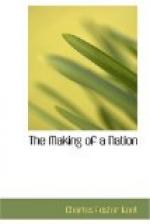The decalogue in Exodus 34 may well represent the original commands which Moses laid upon the nation, but the higher moral sense of later editors has truly recognized the superiority of the ethical commands of the familiar decalogue in Exodus 20 and given it the commanding place which it richly deserves. (For a probable literary history of this decalogue see Hist. Bible I, 194-5.) The two decalogues of Exodus 20 and 34 are not duplicates the one of the other, but rather supplement each other. The one defines the obligation of the nation, the other of the individual. The Hebrews long continued to retain in their homes the family images inherited from their Semitic ancestors. Not until the days of Amos and Isaiah did the prophets begin to protest against the calves or bulls and the cherubim in the sanctuaries of Northern Israel, and even in the temple at Jerusalem. Hence the second command, “Thou shalt not make for thyself any graven image,” some believe comes from a period centuries later than Moses. Possibly, as in Exodus 34:17, it originally read “molten image” and referred to foreign idols. If so, it may come in this older form from Moses. The tenth command which places the emphasis on the motive rather than the act also suggests a maturer age; but with these possible exceptions there is good reason for believing that the spirit and teaching of Moses are embodied in this noble decalogue.
In what respects does the version in Deuteronomy 5 differ from that in Exodus 20? (Hist. Bible I, 195.) Which is probably the older version? What later explanations and exhortations have been added to the original ten words in Exodus 20? In Deuteronomy 5? What was the object of these additions? Are they of real value? Is it profitable to teach them to children to-day?
II.
OBLIGATIONS OF THE INDIVIDUAL TO GOD.
Into what two groups do the ten words in Exodus 20 fall? And what is the theme of each? Is there a real difference between the command of Exodus 34, “Thou shalt worship no other gods” and that of Exodus 20, “Thou shall have no other gods before me”? Did the Hebrews as a matter of fact tolerate the worship of other gods in their midst centuries after the days of Moses? May the Hebrews have originally interpreted the command of Exodus 20 as a demand that Jehovah be given the first place in the worship and faith of Israel? How did later prophets like Elijah and Isaiah interpret it? (See I Kings 18:21 and Is. 6:1-8; 8:13.) The older command in Exodus 34, “Thou shall make thee no molten gods,” was probably intended to guard the Israelites from imitating the religious customs of their heathen neighbors, such as the Egyptians and the Moabites. The command to make no graven image was, it seems, directed not against the public idols but against the private images. These were usually made of wood and were cherished in many




